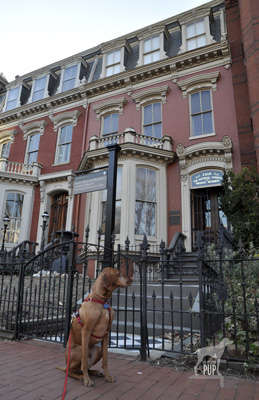
Every March the United States officially observes Women’s History Month—an outgrowth of both International Women’s Day and, in 1981, a congressional resolution for a “Women’s History Week.” In recent years the month has been ascribed a theme, with March 2012’s being “Women’s Education – Women’s Empowerment.”
One who personified this theme through her own works was Mary McLeod Bethune (1875 – 1955), daughter of former slaves, educator, key political influencer, and founder of the National Council of Negro Women (NCNW) in 1935. The Intrepid Pup recently visited two sites, both in the nation’s capital under the aegis of the National Park Service, to learn more.
The Mary McLeod Bethune Council House is tucked within a row of stately townhomes in a residential section of northwest Washington off Logan Circle. For the price of $15,500 in 1943, the property became not only Bethune’s residence but also the official headquarters for the NCNW. The site has been administered by the Park Service since 1994. On the day of our visit, we were welcomed by a college undergraduate serving in the Park Service’s Student Career Experience Program. She invited us first to listen to a recording of Bethune speaking at an event in 1955 just a few months prior to her death. Hearing Bethune’s actual voice was a good introduction to someone we previously knew very little about, and it gave us the impression of a strong yet humble woman with a commanding presence. The ranger gave a brief orientation on the highlights of the home’s history, encouraging us to explore the rooms and interpretive displays on the first two floors. She checked on us several times to answer our questions. We had the house to ourselves that weekend afternoon. Just beyond the reach of the tour bus throngs on the National Mall, this historic site is not a high-traffic destination. Yet contributing to its appeal is the very fact that in providing a personal, intimate experience it is in marked contrast with its crowded counterparts. Our knowledge and appreciation of Bethune expanded exponentially as we uncovered details about her upbringing in poverty and perseverance in starting Florida’s Daytona Educational and Industrial Training School for Negro Girls (now Bethune-Cookman University) in 1904 fueled only by desire and $1.50. It seems fitting that today the university offers a master’s degree program in transformative leadership. It was also fascinating to learn of Bethune’s role in championing African American women’s involvement in the war effort and of her official capacities in the Franklin D. Roosevelt and Harry S. Truman administrations.
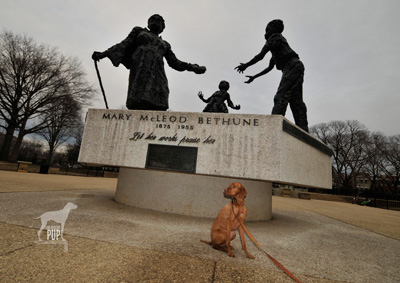
About a mile and half away from the Council House as the crow flies is Bethune in monumental form. Sculpted in bronze by New York artist Robert Berks (1922-2011), the statue grouping emphasizes Bethune as educator, literally and figuratively imparting her legacies to a boy and girl. Around the base are inscribed excerpts from her last will and testament which Bethune also holds in her outstretched left hand. The oft-repeated refrain “I leave you…” is completed by such powerful concepts as “hope”, “a thirst for education,” and “racial dignity.” The monument itself has an interesting history. It’s located in Lincoln Park 11 blocks due east of the U. S. Capitol Building. Book-ending the rectangular plot of open space maintained by the Park Service are the Bethune memorial and, sited directly opposite, the famous Freedmen’s Memorial Monument to Abraham Lincoln (also known as the “Emancipation Grouping”) which was paid for entirely by freed slaves and sculpted by Thomas Ball in 1875. The original intent had been for the dedication of a Bethune memorial to coincide with the 100th anniversary of Lincoln’s Emancipation Proclamation in 1963, but the entire project was delayed. With funding from the NCNW, the Bethune monument was ultimately unveiled in 1974 on what would have been Bethune’s 99th birthday. Adding the Bethune memorial to the park also resulted in turning the Freedman’s Memorial 180 degrees so the two groupings would face each other.
If the Bethune memorial’s roughly faceted, somewhat abstract style looks familiar, it’s because Robert Berks sculpted several high-profile pieces. In DC alone, one can most readily see other examples of his handiwork in the 22-foot seated Albert Einstein memorial (1979) outside the National Academy of Sciences and in the 8-foot, 3000-pound bronze bust of John F. Kennedy (1971) gracing the Grand Foyer of The John F. Kennedy Center for the Performing Arts. In a city dotted with literally hundreds of statues, monuments, and memorials, Berks’ Bethune sculpture represented the first honoring a woman (let alone an African American woman) installed on public park land in the nation’s capital.
Dogging the Details
38°54′29.31″N, 77° 1′50.29″W
Mary McLeod Bethune Council House, Washington, DC
38°53′23.19″N, 76°59′21.13″W
Mary McLeod Bethune Memorial, Lincoln Park, Washington, DC
 There is no fee charged to explore the Bethune Council House. While dogs understandably aren’t allowed inside, the neighborhood itself has sidewalks and is great for dog-walking.
There is no fee charged to explore the Bethune Council House. While dogs understandably aren’t allowed inside, the neighborhood itself has sidewalks and is great for dog-walking.
Lincoln Park is exceptionally dog-friendly and what earns this Bethune-themed expedition a “2” on the Wag-a-meter. In fact, the park’s entire center concourse is basically one big unfenced and very popular dog run. So long as your dog plays well with others, it’s among the top spots to rub noses with the canine denizens of Capitol Hill. During our visit, Tavish encountered 3 weimaraners, a doberman, a rottweiler, a basset hound, a Wheaton terrier, a miniature greyhound, a Boston terrier, and a shepherd mix.
Important to note is that Lincoln Park is not an officially-designated city dog park. There are trash cans, but bring your own your poly bags to clean up after your dog.




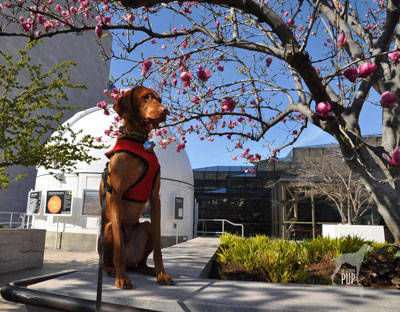 With all the recent talk of feisty solar flares amping up the activity of the Northern Lights and having the potential to wreak a little havoc with power grids and GPS devices here on Earth, the Intrepid Pup turns his attentions to the firmament. And what better place to whet one’s celestial appetite than the
With all the recent talk of feisty solar flares amping up the activity of the Northern Lights and having the potential to wreak a little havoc with power grids and GPS devices here on Earth, the Intrepid Pup turns his attentions to the firmament. And what better place to whet one’s celestial appetite than the 
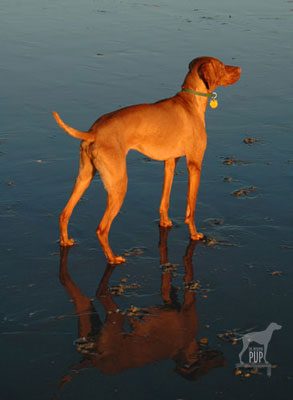 If you’ve always associated Maine with craggy shorelines, there are plenty. But you might be surprised to learn that beautiful sandy beaches can be found in coastal towns throughout southern Maine. One favorite is Kennebunk Beach. At low tide, this crescent-shaped swath of sand extends out about a hundred yards before receding into the Atlantic Ocean. Then, if you could even see this far, the next land you’d spot would be Portugal. Seriously. The surrounding communities, collectively known as the Kennebunks, are tourist magnets (particularly in the summer and fall), but Kennebunk Beach holds a year-round allure even after temperatures for swimming and sun-bathing are but distant memories. The sidewalk follows the shoreline and is great for dog-walking, complete with several waste receptacles and doggie-bag dispensers. In fact, this same scenic route along the seawall is used by the area’s Animal Welfare Society for its insanely popular (and fun) annual “Strut Your Mutt” fundraiser.
If you’ve always associated Maine with craggy shorelines, there are plenty. But you might be surprised to learn that beautiful sandy beaches can be found in coastal towns throughout southern Maine. One favorite is Kennebunk Beach. At low tide, this crescent-shaped swath of sand extends out about a hundred yards before receding into the Atlantic Ocean. Then, if you could even see this far, the next land you’d spot would be Portugal. Seriously. The surrounding communities, collectively known as the Kennebunks, are tourist magnets (particularly in the summer and fall), but Kennebunk Beach holds a year-round allure even after temperatures for swimming and sun-bathing are but distant memories. The sidewalk follows the shoreline and is great for dog-walking, complete with several waste receptacles and doggie-bag dispensers. In fact, this same scenic route along the seawall is used by the area’s Animal Welfare Society for its insanely popular (and fun) annual “Strut Your Mutt” fundraiser.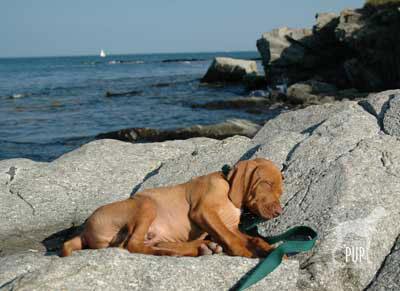 Team Tavish dug back into the Intrepid Pup archives for this pic of an approximately 11-week-old Tavish on one of his very first trips to what would become a frequent destination: Peaks Island. Of the several hundred island communities that dot Casco Bay, Peaks is the most populous with ~1,100 year-round residents, though that number swells to 4,000+ during the summer months. Peaks is actually part of the City of Portland, but its history has been punctuated by various—and as yet, unsuccessful—secessionist movements. It’s accessible via a 15-minute ride from downtown Portland on the Casco Bay Lines
Team Tavish dug back into the Intrepid Pup archives for this pic of an approximately 11-week-old Tavish on one of his very first trips to what would become a frequent destination: Peaks Island. Of the several hundred island communities that dot Casco Bay, Peaks is the most populous with ~1,100 year-round residents, though that number swells to 4,000+ during the summer months. Peaks is actually part of the City of Portland, but its history has been punctuated by various—and as yet, unsuccessful—secessionist movements. It’s accessible via a 15-minute ride from downtown Portland on the Casco Bay Lines 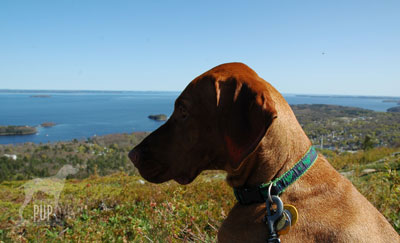 Camden
Camden








